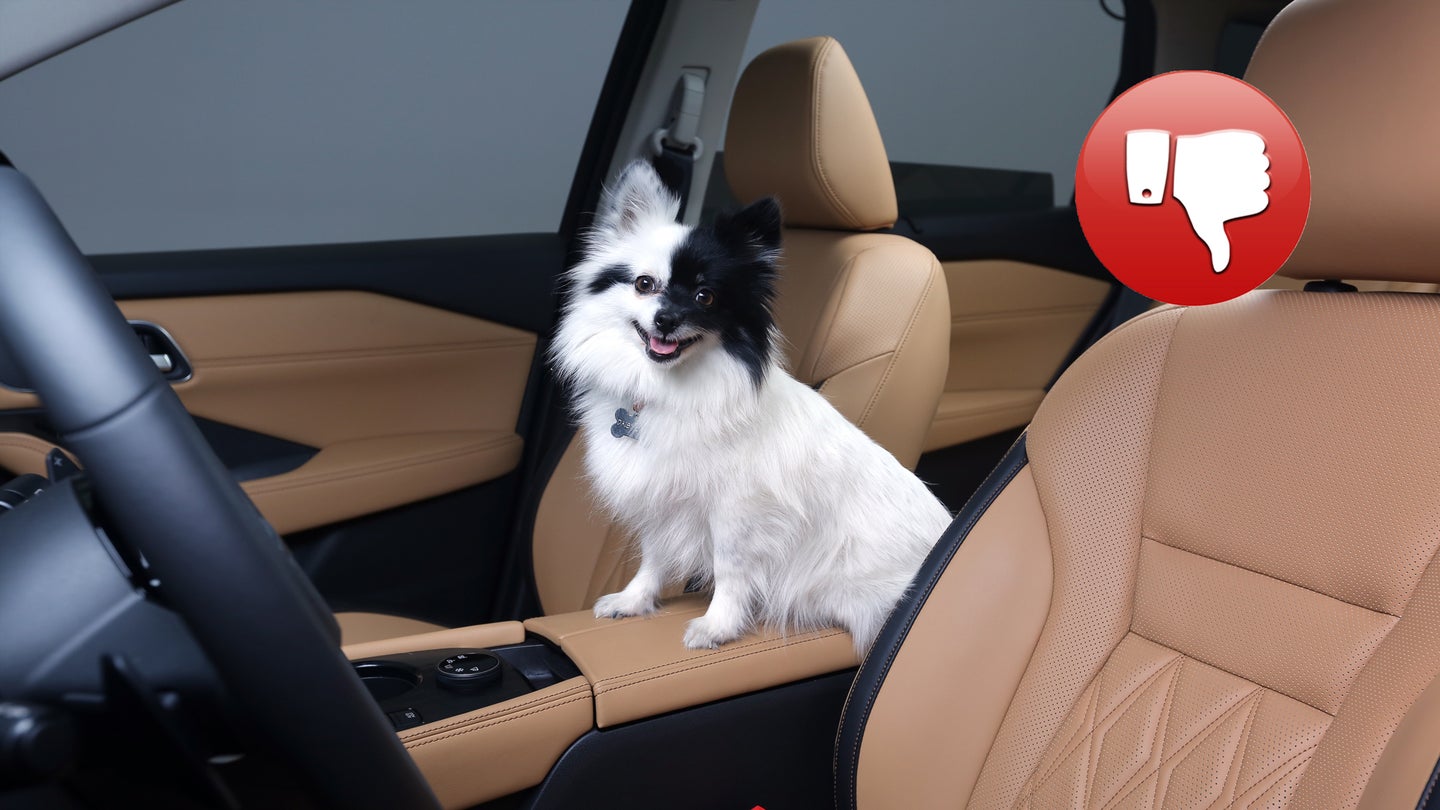Your Dog Needs To Buckle Up. Here’s Why
Don’t let your pooch become a projectile in a crash.

Cat owners, you’ll notice, don’t carry their pets around in little backpacks or drive with their felines sitting on their laps. Dog owners, however, aren’t so chill. I get it; every time I see a dog with his head hanging out the window, it makes me smile. However—and yes, this is a buzzkill, sorry—it is not a smart move for you or your canine companion.
At some point in time in your personal driver education history, you probably learned that unsecured items become dangerous projectiles in the car in the event of a collision. Listen up: if you have a 10-pound dog in the car and you’re traveling 50 mph, that tiny canine could exert a crushing 500 pounds of force on you or someone else in the vehicle if you crash.
Pet adoptions have been on the rise since March. In fact, Rover.com says that 60 percent of recent adoptions are those with little or no previous pet experience. The pandemic has inspired people to add a tongue-lolling ball of fur into their homes, and many of them don’t know that much about pet ownership. That includes how to travel safely in the car with Fido, or Spot, or Princess Puggalicious.
Many owners allow their fur babies to sit in on their laps while they drive, or ride unrestrained in another part of the vehicle. The American Automobile Association (AAA) found in a nationwide survey that 84 percent of Americans have driven with their pet in the car. However, only 16 percent use any form of restraint.
"Bah," you say. "My dog’s not hurting anyone up here on my lap or in the seat next to me." In the aforementioned AAA study, one in six of those surveyed admitted to driving with a dog on their lap. And that’s only the ones willing to cop to it. Imagine that your puppy decides mid-ride that it would be fun to ride on the floorboards under your feet. You’re going to want to avoid crushing it under the brake pedal, for your sake as well as your pet’s.
That means you’ll be distracted and possibly panicked, and that’s not going to end well. At the very least, you could be risking a distracted driving ticket if you cause a collision because the dog is running loose in your vehicle.
Earlier this summer, Nissan put out some automotive dog safety guidelines, and they're good ones. Based on that, and some of my own research, I came up with some general best practices you may find useful:
Click it, don’t… lick it? Pets can be unpredictable in a moving car, and they can cause accidents when they get loose in the car. As you would imagine, you’d be swerving and driving erratically. It’s driving under the influence… of a cute pooch.
Don’t take your hands off the wheel. Nearly one in five respondents to the AAA/Kurgo survey admit to taking their hands off the wheel to keep their dogs from climbing into the front seat. Any parent knows this drill because they have probably handed Goldfish crackers and juice boxes back to their progeny just an arm’s reach away. It’s not a good idea then, either.
Don’t allow a pet to ride with its head out of the window. I know. Everybody loves seeing a dog with the wind blowing in its hair, panting contentedly. Consider this: any obstacle close to the vehicle could strike your dog in such a way to injure or kill it, even if you get too close to a tree branch. On the less-deadly-but-still-may-require-a-vet-visit side, dirt, bugs, and dust could lodge itself in your pet’s ears, nose, eyes and throat. If your dog thinks he’s Evel Knievel, he might even try to jump out of the car; then all hell breaks loose.
“Statistically, most accidents happen close to home,” said Brandon Sanders, a product safety expert at Nissan North America. ”So it’s important even on short trips.”
These tips will help pet owners create better restraint options for their pups:
1. Harness: A chest-style harness in the back seat is a great way to keep medium to large dogs in place during long and short trips. Check the manual for the pet harness to ensure you’re running the seat belts through the appropriate loops. Sanders said this is a much better option than a collar alone, which can result in whiplash or worse. Clip the harness to a restraint tether into the seat belt buckle or child-seat anchor for comfort.
2. Crates and carriers: Use seat belts to secure smaller dogs in portable pet carriers in the second or third row of your vehicle. Smaller carriers can also be placed on the floor between the front and second row to limit movement. Medium and large pets can ride in a sturdier kennel secured to the vehicle cargo area in SUVs or trucks, fastened to the vehicle as securely as possible.
3. Cargo area dividers: If you’re driving a large SUV, consider installing a divider behind the last row of an SUV. This is a great way to keep large dogs out your way while driving; just remember that also securing them with a harness is a smart idea.
If you’re a new puppy owner, start them out right and don’t let them ride on your lap. As an enthusiast, you’ll understand that once they get behind the wheel they’re not going to want to sit in the back.
